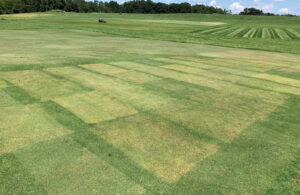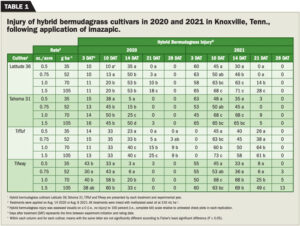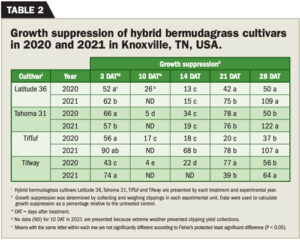Researchers evaluate imazapic growth suppression of hybrid bermudagrass
Turfgrass managers use plant growth regulators (PGRs) to reduce mowing requirements, suppress inflorescence production and improve overall turfgrass quality (8, 16, 20 and 21). Recent surveys indicate that 45 percent of all golf courses in the U.S. apply PGRs (22).

Researchers at the University of Tennessee evaluated the growth suppression of imazapic on hybrid bermudagrass cultivars.
The five primary types of PGRs used in turfgrass management are:
- Class A compounds: Suppress gibberellic acid (GA) biosynthesis late in the pathway.
- Class B compounds: Suppress GA biosynthesis early in the pathway.
- Class C compounds: Inhibit cell division by reducing total nonstructural carbohydrates in leaves.
- Class D compounds: Herbicides with growth-regulating properties.
- Class E compounds: Considered phytohormones (6, 16, 24 and 25).
Imazapic is a herbicide used for pre and postemergence control of grassy and broadleaf weeds in various systems, including maize, rangeland, pasture and roadsides (1, 2 and 15). Past research explored imazapic efficacy for seedhead suppression in managed and utility turfgrass (3, 4, 9, 10 and 26). For example, tall fescue growth suppression following imazapic application on roadsides reduced mowing events required to create clear sight lines for motorists (7, 9, 10 and 13).
Reductions in labor availability have challenged many turfgrass managers to meet the mowing requirements of bermudagrass on golf courses (12). More than 159,284 ha of maintained bermudagrass on golf courses across the United States in 2021 required regular mowing (23).
Applications of imazapic as a PGR could assuage this issue. For example, imazapic at > 0.5 oz./acre (> 35 g/ha–1) reduced bahiagrass plant height by ≥ 30 percent; however, these applications resulted in 30 to 50 percent injury through 119 days after treatment (DAT) (18).
Comparatively, imazapic at 0.5 oz./ acre (35 g/ha–1) only injured bahiagrass 23 percent 14 DAT which reduced to 4 percent by 56 DAT (18). Other research found inflorescence suppression with imazapic applications to bahiagrass and zoysiagrass in the U.S. transition zone (4 and 26). On Riviera bermudagrass, imazapic at 0.75 oz./acre (52 g/ha–1) resulted in ≤ 15 percent injury, reduced inflorescence production and suppressed growth (3).
Although tolerance of common bermudagrass to imazapic for use as a PGR has been explored in the transition zone of the U.S. (3), information about the response of hybrid bermudagrass is lacking, considering the species consti- tutes 32 percent of all maintained turfgrass hectarage on golf courses (23). Limited research demonstrated imazapic applications at 0.5 to 1.5 oz./acre (35 to 105 g/ha–1) reduced hybrid bermudagrass plant height by ≥ 28 percent, suggesting that it could be a tool to aid turfgrass managers in reducing mowing requirements on golf courses (19).
Our research objective in this study was to evaluate hybrid bermudagrass tolerance and growth suppression following applications of imazapic.

Materials and methods
We conducted field experiments on Aug. 14, 2020, and repeated them on Aug. 6, 2021, at the East Tennessee AgResearch and Education Center, Plant Sciences Unit in Knoxville, Tenn., to evaluate injury and growth suppression of hybrid bermudagrass cultivars following appli- cation of imazapic. Separate experi- ments were conducted each year on four hybrid bermudagrass cultivars: Latitude 36, Tahoma 31, TifTuf and Tifway.
Experimental areas were maintained with a reel mower three times per week at a 1.6- or 1.3-cm height of cut in 2020 and 2021, respectively. The soil at all experimental sites was a Sequatchie silt loam, and we irrigated to supplement rainfall on all plots.
We arranged each experiment as a randomized complete block design with four replications of 1.5 m2 plots. Treatments included single applications of imazapic (Plateau, BASF) at 0.5, 0.75, 1.0 and 1.5 oz./acre (0, 35, 52, 70 or 105 g/ha–1) mixed with methylated seed oil (0.2 gal/acre or 1.75 L ha–1). Treatments were applied using a CO2-pressurized backpack sprayer calibrated to deliver 40 gallons/acre (374 L/ha–1) via 8002 TeeJet nozzles.
We assessed hybrid bermudagrass injury 3, 10, 14, 21 and 28 DAT using visual measurements of the normalized difference vegetation index (NDVI). We visually rated turfgrass injury on a 0 to 100 percent scale, where 0 = no turfgrass injury and 100 = complete kill relative to untreated check plots in each replication. We used a FieldScout TCM 500 hand-held NDVI meter (Spectrum Technologies Inc.) on each date the visual injury was rated to collect three measurements per plot.
We evaluated growth suppression by collecting clippings from a single pass with a reel mower (22 inches [55.5 cm]) wide in the center of each plot on each rating date. We avoided mowing the plots for 48 hours before a clipping collection event and mowed the entire plot after collecting the samples. Clippings collected were dried in a forced-air oven at 54 degrees C for at least two days and weighed. Clipping weight data were expressed as a percentage of the untreated check to quantify the degree of growth suppression following imazapic treatment.
We analyzed hybrid bermudagrass injury and growth suppression data from all plots (N = 160) using a repeated- measures analysis of variance and a means separation technique (least squares means). Treatment means for significant effects were separated using Fisher’s protected least significant difference test (P = 0.05). Pearson’s correlation coefficients were calculated for turfgrass injury and NDVI data.
Results and discussion
We found a treatment-by-cultivar-by- year-by-rating date (DAT) interaction in hybrid bermudagrass injury data; therefore, data were presented separately by cultivar and year. Turfgrass visual injury data correlated significantly with NDVI assessments (r = –0.53; P ≤ 0.001), similar to previous reports outlining the relationship between qualitative and quantitative measures of herbicide performance (5 and 11). Therefore, we only present the visually rated injury data.
Hybrid bermudagrass injury means are presented based on treatment, cultivar, year, and DAT (Table 1). Hybrid bermu- dagrass injury increased with imazapic rate for all cultivars in both years; however, injury was less pronounced in 2020 compared with 2021. For example, 10 DAT in 2020, no cultivar was injured > 38 percent with imazapic at 35 g/ha–1, whereas in 2021, this treatment resulted in upward of 48 percent hybrid bermudagrass injury (Table 1).
Peak hybrid bermudagrass injury following imazapic treatment (regardless of rate) occurred within 14 DAT for all cultivars each year; however, the degree of injury varied by year, which may be related to environmental conditions, particularly increased precipitation during the data collection period in 2021 compared with 2020.
The activity of imidazolinone herbicides (such as imazapic) in the soil is greater when moisture is nonlimiting (14) and can lead to crop injury. For example, increased rainfall leading to greater imazapic availability in soil solution has been identified as a cause of exacerbated imazapic injury in rice (17).
In our study, peak injury of Latitude 36 was 35 percent following treatment with imazapic at 35 g/ha-1 in 2020 compared with 60 percent in 2021 when precipitation nearly doubled (Table 1). Similar responses were also observed for Tahoma 31, TifTuf and Tifway in 2020 and 2021. However, all cultivars recovered (0 percent injury) by 28 DAT each year following treatment with imazapic at 35 g/ha–1.
These findings suggest hybrid bermudagrass is less tolerant to imazapic applications for growth suppression than common bermudagrass. We reported 15 and 17 percent common bermudagrass peak injury year over year with imazapic at 52 g/ha–1 at the same research location (3). Comparatively, hybrid bermudagrass peak injury was ≥ 35 percent between 10 and 14 DAT (across cultivars and years) with imazapic injury reported herein greater than that observed for other warm-season grass species (18 and 19), which may be a function of mowing height. Turfgrass was maintained at ≤ 0.63 inches (1.6 cm) in our study compared with a 3- to 5-cm range in work conducted on bahiagrass and St. Augustinegrass (18).
We observed a significant year-by- cultivar-by-DAT interaction; therefore, growth suppression data were presented separately for each cultivar and year (Table 2). A significant imazapic rate- by-DAT interaction was present for growth suppression data collected for Tahoma 31, TifTuf and Tifway in 2020.
Differences in growth suppression were detected among cultivars each year (Table 2). In 2020, imazapic reduced dry clipping weight by 37 to 56 percent across all cultivars compared with the untreated check. In 2021, dry clipping weight was reduced by 39 to 78 percent across all cultivars by 21 DAT; however, rebound growth occurred, with dry clipping weight measuring 64 to 122 percent of the untreated check by 28 DAT.
Dry clipping weight for all cultivars other than Tifway was ≥ 100 percent of the untreated check by 28 DAT in 2021. Similar to our turfgrass injury assessments, greater growth suppression in 2021 could be related to increased precipitation. Peak growth suppression following imazapic treatment occurred 10 to 14 DAT for all cultivars in both years, with the exception of Tifway in 2021.
Imazapic reduced hybrid bermuda- grass dry clipping weight effectively for all cultivars each year. For example, at 10 DAT in 2020, dry clipping weights were 4 to 26 percent of the untreated check regardless of cultivar. In 2021, we saw similar reductions at 14 DAT for Latitude 36 and Tahoma 31. Growth suppression with imazapic in our study was comparable to that reported for other warm-season turfgrass species (18 and 19).
Imazapic (35 g/ha–1) could be used to suppress hybrid bermudagrass growth on golf courses if commercially unacceptable (albeit transient) injury (> 30 percent) is tolerable for up to 28 days after the application. This is particularly important given that the species constitutes 32 percent of all maintained turfgrass hectares on golf courses.
Our study was limited because imazapic was applied singly to cultivars maintained at mowing heights less than 0.63 inches (≤ 1.6 cm) on a single soil type. Moreover, we did not directly compare the effects of imazapic to other PGRs used commercially in turfgrass, including trinexapac-ethyl, paclobutrazol, and flurprimidol. Future research to understand these limiting factors is warranted, given that turfgrass tolerance to imidazolinone herbicides can be affected by climatic zones (4).
<p>The post Researchers evaluate imazapic growth suppression of hybrid bermudagrass first appeared on Golfdom.</p>

